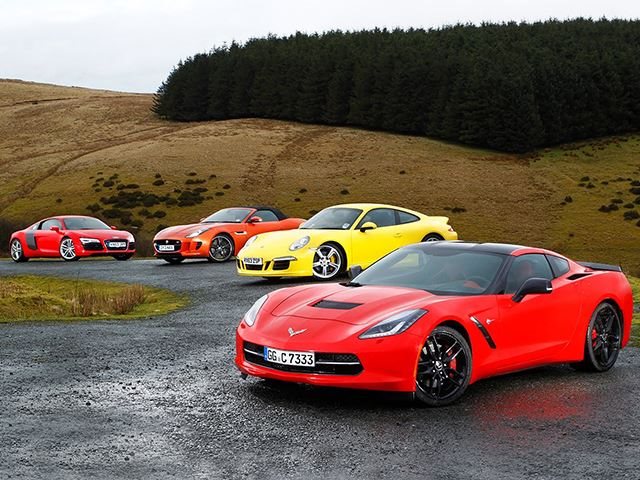Most people would put American muscle cars and Germany’s luxury sports cars into two separate classes. Muscle cars are known for being cheap and featuring big V8s whereas Germany’s luxury sports cars are pricey and put handling over straight-line speed (though they were still plenty quick). But nowadays it seems like the two sets of cars are equal in all areas except price. Or are they? To find the answer we’ve turned to our own Gabriel Beita-Kiser (pro Germany) and Michael Hines (U-S-A, U-S-A) for help.


If you’re in the market for speed, why buy something fancy when it can go as fast as a car that costs half as much? This is a tough issue to flesh out when it comes down to raw performance numbers, but sit behind the wheel of a German sports car and an American muscle car and the differences in price become as clear as day. Just look at the Viper SRT and the Audi R8 V10. Okay so the Audi costs $105,000 more than the Dodge, but you're also getting a whole lot more car. If you need something to adorn your McMansion, go with the Viper, but if you actually want to drive, take the R8. Even though it weighs 360 pounds more than the Viper and has only 30 less horsepower, it accelerates faster.
From standstill, 60 mph comes 0.7 seconds quicker than in the Viper. And in the R8 you can manhandle corners. The Dodge requires a life insurance policy to even turn the wheel. These characteristics make speed more accessible and puts German sports cars in another league. Thank me later when you’re enjoying the scalpel-like precision of a Porsche 911 GTS and not spending time complaining about how the ZL1 Camaro sucks to drive around town. Speaking of the two, what does a $33,950 difference between the two cars get? The Porsche has 210 horsepower less than the Camaro, but it hits 60 mph from standstill 0.2 seconds quicker. The Porsche will also turn more heads, handle gloriously, and come with every electronic toy in the book.


This serves to make city driving pleasurable while also letting you crush all comers at the track. The truth is that, despite being fast, the selling points of most muscle cars are just cheap and gimmicky add-ons. Chevy makes a big deal about the aerodynamic "Flowtie" on the ZL1, but you could buy a Mercedes AMG GT with a real active wing and stop playing. Cheap American muscle tries to make up for the gap in quality with brute force, but it just feels wrong when even the carbon fiber looks like a pasted on afterthought. There's no problem with cutting costs and maintaining power to meet a budget, but for those with the cash, splurge and live without regret.


The automotive community is one of the most prejudiced groups of people on the planet. Gearheads routinely judge cars based on badges alone. Yes, automakers have established certain reputations over time, as have certain models. Seismic shifts in the industry happen all the time, yet people are slow to acknowledge them, if they do at all. One of these shifts is the closing of the gap between America’s best muscle cars and Germany’s luxury sport cars. In a recent episode of Motor Trend’s “Head 2 Head,” hosts Jason Cammisa and Jonny Lieberman both picked the new Camaro SS over the BMW M4. The Camaro’s 6.2-liter V8 is bigger and more powerful than the M4’s 3.0-liter twin-turbo inline-six at 455 hp and 455 lb-ft of torque vs. 425 hp and 406 lb-ft of torque.
The BMW weighs 184 pounds less, though. Both are beauties, and there’s only one major difference between them. As tested the M4 was $81,045 while the Camaro SS was $46,095. That’s $35,000 for a badge and bragging rights. Speaking of bragging rights, the Dodge Viper ACR, equipped with the optional Extreme Aero Package, ran a faster lap at Laguna Seca than the Porsche 918 Spyder. Price difference: around $1 million bucks. It’s very American to say “bigger is better.” But what about things that you can’t measure in numbers, like quality? That gap has closed too. The Corvette was best in its class (midsize premium sporty car) in J.D. Power and Associates 2015 Performance and Design Ratings & Awards.


It beat out the Porsche 911 and the Mercedes-Benz SL-Class. With the exception of the Challenger, today’s American muscle cars are leaner and more athletic than ever before. They're just better all around. Even the Germans have taken notice. There was that Corvette police car and that funny sales month in Germany (March 2016) when the Mustang beat out both the Audi TT and Porsche 911 (and Cayman/Boxster) to be the country’s top sports car. True, America still has a long way to go before its muscle cars will be as highly regarded as Germany’s sports cars. But the gap has shrunk drastically and in certain situations you could argue that it doesn’t exist at all…or that it’s flipped entirely.




